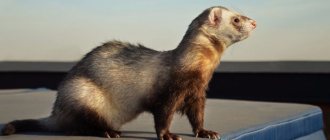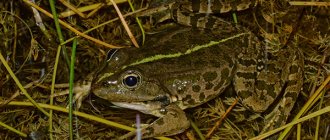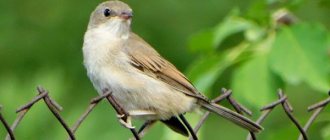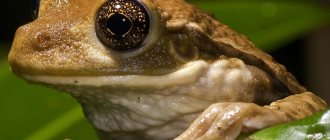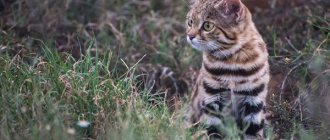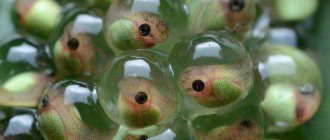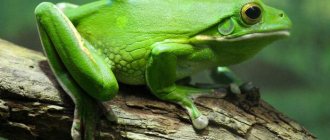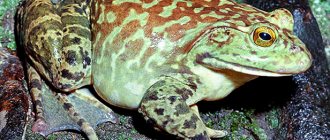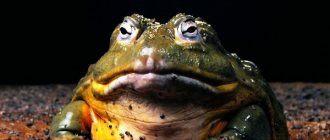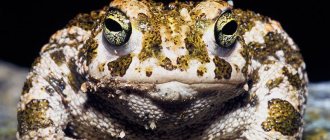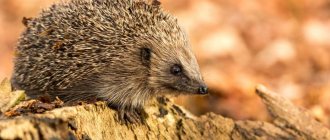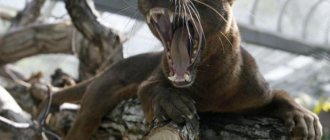Behavior and temperament of the African bullfrog
African bullfrogs are moderately active but fun to watch in their aquariums. Overall, they tend to be calm animals that do not require much care.
Be prepared to feed them every other day or so and clean the tank once or twice a week. Also note that males should not be housed together as they can be territorial.
Male frogs will also guard—and sometimes eat—their tadpoles in the wild.
Some African bullfrogs tolerate little handling for a short period of time. But you should still be careful when handling them to protect their delicate skin.
Additionally, they can easily use their powerful legs to jump out of your hands and potentially hurt themselves. Additionally, these frogs have sharp teeth and are known to bite people who handle them.
They usually croak loudly to let you know when they feel stressed. But if you respect their boundaries, you should have a laid-back pet.
How the pixie was operated on
Among the subgenera of True frogs (Rana)
One of the most popular and extremely spectacular anuras is the water frog
(Pyxicephalus adspersus),
also known as the speckled burrowing frog, or the South African bullfrog. Terrarists call it familiarly “pixie” (after its subgeneric name). She has a huge head, reminiscent of the head of a slingshot, as well as numerous longitudinal folds of greater or lesser length. They are located on the back and sides of the pixie, and between them there is grainy skin that stretches to the hips. Its back is usually bright olive green, less often brown, and covered with dark spots. A light line stretches along the ridge. The belly is yellow; in young ones it is white, sometimes the throat is covered with dark spots.
It reaches a length of 25 cm. And, surprisingly, the width of the frog is almost equal to its length! Distributed in Eastern, Central and Southern Africa (from Sudan to South Africa), where it is most common in Namibia. Inhabits semi-deserts, savannas and sparse thorny thickets.
This is how American terrariumist Rex Lee Sirey characterizes this frog: “One of the “coolest” and rowdiest frogs... Even though you are sicker than it, it is better to give way to it. This frog eats everything it can fit into its mouth - everything it can eat. It is known that it is resistant to any poisons, and therefore devours scolopendras, scorpions and even cobras. When you follow the “pixie”, she follows you in the same brazen manner, apparently thinking like this: “I wonder if I can swallow this creature?”
The substrate for “pixies” is gravel, just like for slingshots, but they are even more voracious, and, therefore, they need to be cleaned more often. Sometimes an ordinary aquarium is used for this: it is filled with water a few centimeters and flat stones are placed in it, on which the water bearer blissfully rests. This makes caring for the frog easier.
The biological feature of this species is hibernation, associated with inactivity during periods of drought. The mechanism for maintaining moisture during this period is that animals surround themselves with a capsule (cocoon) of mucus secreted by the skin. Hardened mucus protects the pixie from drying out, and only the nostrils remain open. In this state, the frog can breathe for more than six months if the rains are for some reason late. This rhythm usually precedes mating, coinciding with the rainy season. Crawling out after a rainstorm, the “pixies” perk up, fill their bellies with food and begin to reproduce. The mating call of males is very similar to the lowing of a calf. In captivity, similar conditions are created artificially using the mentioned technique. The indigenous population of Africa is very fond of juicy pixie meat, as are the white settlers.
Water frog (Pyxicephabus adspersus)
Here is what the famous pioneer of South and Central Africa, Scottish missionary David Livingstone (1813-1873), reports: “Another kind of food that our children ate with pleasure were unusually large frogs called “matlametlo.” According to the natives, these huge frogs, which, when cooked, look like large chickens, fall out of thunderclouds, because after a thunderstorm shower, the water-filled depressions instantly become inhabited by this loudly croaking and grumbling living creature. This phenomenon takes place in the driest places of the desert, precisely where no sign of life is noticeable to the inexperienced eye... When they rush into depressions filled with thunderstorms, then immediately, simultaneously, the singing of their choir is heard from all sides, announcing their “ descending from the clouds"... In other places, after a long journey through the waterless desert, this music is considered the most pleasant sound to the ear..."
Related species are also noted in the subgenus: P. obbianus, P. edulis
(as the name “edible” eloquently indicates) and
P. delandi.
All of them are characteristic of sub-Saharan Africa.
P. edulis
is half as long and not as pugnacious.
P. delandi
is even smaller, similar to a tiny water carrier, and is a first-class choice for the young terrarium hobbyist.
But nevertheless, the “crawfisher”, which eats cobras and scorpions, can get sick and end up on the operating table. An amazing operation was carried out in 1998 by specialists from the Nikolaev Zoo (Ukraine) O.G. Yavkin and N.V. Vychalkovskaya: “At the age of two, the male had a tumor removed on the first toe of the left hind limb. The tumor was a pea-shaped growth of irregular shape, pale pink, penetrated by small injected vessels. The neoplasm was periodically injured, bled and noticeably interfered with the animal's movement. The tumor was removed along with the first phalanx of the finger, and the wound was treated daily with dry white streptocide until complete healing.
On February 20, 1998, multiple neoplasms of the soft palate were removed from the same individual. We assume that in this case, fibromas developed due to possible microtraumas of the mucous membrane of the aquifer during the period of suspended animation...
In our case, on December 14, 1997, two water carriers were placed on a dry peat bed. However, we were forced to bring the animals out of suspended animation due to the deterioration of the male’s condition, which was reflected in severe sinking of the sides, sharp delineation of the spine and especially the sacrum. During feeding, it was noted that the male swallowed with difficulty, and bubbles of mucus were released from the nostrils and mouth. We assumed that during suspended animation, particles of the cocoon got into the nostrils, which made breathing difficult. After several attempts to suck out the mucus from the nostrils, this version disappeared. The animal began to move little, looked depressed, and on 02/10/98 completely refused food. By this time, neoplasms of the palate became noticeable, and we decided to operate on the animal.
The operation proceeded as follows. The water carrier was injected intramuscularly with 0.3 ml of a 5% ketamine solution (based on 900 g of weight). After 5 minutes, the pupil constricted, breathing became shallow, and muscle relaxation was noted. After another 5 minutes, the animal was completely anesthetized. The frog's mouth was opened and secured with bandages.
The tumors were spherical in shape and ranged in size from a pea to a quail egg. Since the surgical field could not be treated with alcohol-containing and tissue-irritating preparations, we treated it with a 1:2,000 solution of furatsilin and then irrigated it with a 10% solution of lidocaine. A 2% novocaine solution was injected into the area of the tumor stalks.
Anatomical and topographical data of the upper jaw of most tailless amphibians indicate a significant reduction of their hard palate. The main part of the roof of the oral cavity, as well as the infraorbital fenestrae of the skull, is covered only by a thin tissue septum... In this regard, surgical manipulations in amphibians must be carried out with extreme caution to avoid perforation of the septum.
Using ophthalmic scissors and a scalpel, the tumors were removed by cutting off the tumor stalks from the palate. To stop bleeding, tampons soaked in a 0.13% solution of adrenaline were used. The wounds were treated with a suspension prepared from 0.5 g of kanamycin and 2 ml of sterile tetravit.
To quickly recover from the state of anesthesia, the animal was injected subcutaneously with 0.2 ml of a 10% solution of caffeine benzoate and the animal was placed in a bath of warm water. Unlike mammals, amphibians take longer to recover from anesthesia. In this case, the animal woke up four hours later. Over the next six days, the wounds were treated with sea buckthorn oil.
On the fifth day after the operation, the water bearer ate 10 marbled cockroaches (the first three were force-fed), and the next day - six newborn mice.
On March 19, 1998, that is, a month after the operation, the male showed sexual activity towards the female.
The pathological and morphological department of the regional laboratory of veterinary medicine classified the tumors as fibromas.”
More interesting articles on the topic:
“WATER MONKEY” IN THE AQUARIUM
“WATER MONKEY” IN THE AQUARIUM Oscar Heinroth, famous German ornithologist and researcher
Barking tree frog (Hyla gratiosa)
Barking tree frog (Hyla gratiosa). The name of this tree speaks for itself: its voice (
Slingshots, or ithania (Ceratophrys)
Slingshots, or ithania (Ceratophrys) Although ithania are sometimes mistakenly called "toads", they
Far Eastern tree frog (Hyla japonica)
Far Eastern tree frog (Hyla japonica) Another species of tree frog that lives in Russia - kv
DEATH BEAUTIES: LEGENDS AND FACTS
DEATH BRINGING BEAUTIES: LEGENDS AND FACTS According to a very authoritative source, the Book of Recor
"HEAVYWEIGHTS" IN ALL YOUR GREATNESS
“HEAVYWEIGHTERS” IN ALL THE BEAUTY Among the ecological groups of tailless amphibians, one can group
Housing for the African bullfrog
Pet frogs are fairly easy to care for, but you need to make sure your habitat is set up correctly. The larger your frog, the larger your aquarium should be.
A medium-sized African bullfrog should have a tank capacity of at least 45 liters; the bigger, the better.
You can use small smooth stones for the bottom of the tank. Fill it about a third full with dechlorinated water, and then use increasingly larger rocks to build up one side of the tank to create a beach.
This will give them something they can easily climb onto and allow them some time to get out of the water when they want to dry off. To keep the water fresh, you need to clean the tank once or twice a week or more often.
A container of soil may also be provided in case your bullfrog wants to burrow. In the wild, African frogs burrow into the mud and hibernate for up to two years to avoid drought.
However, in captivity we can control the temperature and humidity in which our frogs live, eliminating the need for them to hibernate.
Kinds
There are about 18 species. The most famous is the common clawed frog . A species that scientists often use is the smooth frog . She is often kept as a pet. Xenopus is an inhabitant of South Africa. This species is easily recognized by its olive body and white belly with dark spots.
Smooth frog
And the albino frog , which scientists bred, has long attracted the attention of aquarists. This is a fairly large amphibian, its body length is about 15 cm. The entire body of the frog is pink. This species constantly suffers from obesity, which is why individuals live much shorter than their counterparts.
Albino clawed frog
The African dwarf frog inhabits Nigeria and Zaire. The amphibian's body is elongated, but small - its length is about 4 cm. This frog has no eyelids and a pointed muzzle.
African dwarf frog
Böttger's clawed frog is a dark gray frog with a light belly. In captivity it feels good and reproduces better than in its natural environment. An individual of this species can be recognized by its gray body and almost white belly.
The American pipa is almost the largest amphibian in its order. The frog's body is flattened, its length is 20 cm. The amphibian is covered with thin skin, dotted with wrinkles. The color is usually brown. The frog smells like hydrogen sulfide.
American pipa
The toaded toad is a 6-centimeter amphibian with lumpy brown skin. There are many green spots on the frog's body. The amphibian's abdomen is orange, with many blue spots on it. The frog has very large eyes with triangular pupils. Due to the unusual structure of the tongue, whose lower part is attached to the oral cavity, the toad cannot croak.
Toadstool
Substrate
The substrate is the material that covers the bottom of your frog's enclosure. This helps maintain humidity in the environment and can make the aquarium feel more like the animal's natural habitat.
Coconut fiber, made from coconut husks, is a good option as a substrate.
Another option is peat moss. The ideal option is an organic product that retains some heat and moisture. Avoid using soil treated with insecticides or other chemicals.
Make sure it is clean and change it frequently. African bullfrogs are known to eat the substrate in their cages, so any material covering the enclosure should be easily digestible.
What do frogs eat?
Copyright for poison
In addition to the risk that people expose themselves to by using opiates and trying to “cure” with them, the spread of kambo also harms the indigenous population of the Amazon. In the 1980s and 90s, after the composition of kambo peptides became known, pharmaceutical companies began to patent them.
This is not surprising: at that time, the pharmaceutical industry showed great interest in other substances discovered in the Amazon (among them, for example, the venom of the Brazilian viper, on the basis of which a blood pressure drug called Captopril was developed in the 1970s). But in the end, no medicine was developed from Kambo peptides.
They didn’t develop a cure, but they made enemies: in 2003, the Katukin Indians accused the pharmaceutical companies that patented Kambo peptides of biopiracy.
According to them, the rights to the medical use of kambo belong exclusively to the Katukina and other Amazonian tribes. In 2004, in response, the Brazilian government banned all advertising of kambo's medical or therapeutic uses, effectively making the drug illegal for urban use.
But since kambo remains legal in other countries, adventure seekers, as well as kambo businessmen, regularly visit the tropics. Thus, the tribes are still faced with the theft of their “intellectual property”, but they cannot do anything about it.
It must be said that copyright violation for poison is just a small thing compared to the problems that local Indians need to cope with: drug trafficking passes through their territories, the jungle in their places of residence is being actively cut down.
In addition to harm to kambo practitioners and the Matses Indians, phyllomedusa frog populations may suffer in the future due to the industrial production of kambo sticks.
Food and water
These large frogs are true carnivores. A healthy bullfrog diet consists of gut-loaded crickets (crickets that are fed a nutritious diet that is passed on to your pet), mealworms, and other available insects.
This also includes small rodents such as mice and rats called fuzzies, and even other smaller amphibians.
Stay away from grocery store meats such as chicken and beef. This muscle meat does not provide the frogs with the same nutrition as whole foods.
Young frogs usually eat daily or every other day, while adults eat two to three times a week. Place food in a shallow dish or on a flat stone.
It is best to change what is on the menu at each feeding to a varied diet that mimics what they get in the wild. Also, don't overfeed these voracious eaters.
Consult your veterinarian to determine how much to feed at each meal, depending on the age and size of the frog. Finally, you can offer small dishes in addition to the aquarium water if you wish.
Keeping in an aquarium
It is best to keep clawed frogs as part of a group. It is important that there are more males than females.
To keep these amphibians, you should select a long and not very deep aquarium. After all, these tailless creatures constantly crawl along its bottom. They don’t need land, so the aquarium is filled with water so that there is an air gap on top - every 10 minutes the amphibians come up to breathe air. So, to contain 1 frog, you will need about 40 liters of water. But for a group of 3 individuals only 80 liters are needed.
The top of the aquarium is covered with a lid, because these tailless creatures are constantly jumping. If the lid fits tightly to the “house,” then holes are made in one wall of the aquarium.
General health and behavioral problems
Although these frogs live for many years, they do not require much health care. If the environment is warm and humid enough, your frog should not have any skin problems.
However, bacterial and fungal infections of the skin and eyes are common in pets that live in less than ideal conditions.
Intestinal parasites can also be a problem with pet bullfrogs. If the tank temperature is high enough and the frog is still not eating well, take it to an experienced exotics veterinarian to rule out parasitism. An annual stool sample should also be checked.
Also, be on the lookout for ammonia poisoning. This occurs when a frog is left in an enclosure with too much waste.
Symptoms include lethargy, uncoordinated movements and blurred eyes. Death may occur within a few days. Clean the tank as soon as possible and call a veterinarian.
Reproduction
Crawling out of the ground after a long-awaited downpour, the water bearer begins to actively obtain food, preparing for mating. During the mating season, males make loud sounds that vaguely resemble the roar of calves.
Water bearers reach sexual maturity at approximately 8 years of age. Active mating games coincide with the height of the rainy season. Representatives of the species crawl into shallow bodies of water, where they mate. While searching for a sexual partner, such animals become quite aggressive, jealously defending their territory.
Fertilized females are capable of laying about 4,000 eggs in shallow water. Each embryo is no more than 2 mm in size. The eggs are black and white in color and are enclosed in a dense capsule. Incubation takes several days. Then grayish tadpoles are born and quickly gain weight.
Metamorphoses begin to occur with newborn frogs after 18 days have passed from birth. Young representatives of the species, whose tail has only recently fallen off and limbs have formed, measure up to 2 centimeters. It is noteworthy that only about 20% of individuals from one clutch survive to sexual maturity. The rest die after being eaten by other animals, as a result of lack of food, or under the influence of unfavorable environmental factors.
African bullfrog selection
Purchase an African Bullfrog from a reputable breeder. Search the Internet for reptile and amphibian groups or ask your local pet store for recommendations.
A healthy African bullfrog will have typical olive green skin without any abnormal bumps or lesions, and clear eyes. Cloudy eyes may indicate illness.
Males grow much larger than females, so if you prefer a smaller frog, you can choose a female.
But don't expect a miniature, obedient pet; females are just as voracious and sensitive to handling as males.
Getting kambo, Peru
The technique for collecting the poison is quite simple - the frog is stretched by its legs in an X shape and spit on it three to four times, although there are some other options. When irritated, the phyllomedusa releases a secretion from the pores on the skin. When collected with a special wooden spatula, the poison crystallizes quite quickly and is stored well in this form. To use it, just re-dilute it with a drop of water.
After collecting the substance, the frog is released. It is argued that this procedure does not cause significant harm to her. Moreover, according to local beliefs, Kambo is the first and most important spirit of the forest, and harming its incarnation can seriously anger it and bring on a series of failures. And it’s much worse here when everything is falling out of hand and women are shunned.
Popular articles: Tibetan medicine mucus. Diagnostic overview
Fish
Big tiger fish
The great tiger fish, also known as the giant hydrocine, is a very large, freshwater, predatory fish in the family Alestidae. It is found in the Congo River basin.
This predator grows up to 1.8 m in length and weighs 50 kg. Large tiger fish are ichthyophages, feeding on any fish they can handle, including smaller relatives.
Kalamoicht
Kalamoikht or snake fish, lives in West and Central Africa. Mainly found in freshwater rivers and lakes. The diet consists of small animals (insects and worms).
Kalamoikht reaches a maximum total length of 37 cm. It has an eel-like, elongated body without a ventral fin. The long dorsal fin consists of a number of well-separated spines. Kalamoicht has a pair of lungs, which allows it to breathe atmospheric air. This allows the fish to survive in water with low dissolved oxygen.
Senegalese multiply
The Senegalese polyfin is found in lakes, rivers, swamps and floodplains of tropical Africa and the Nile river system.
It is an elongated fish, usually gray or beige in color, sometimes with shades of white, pink or blue. Most of the body is covered in very fine patterns with occasional dark spots or dots. The serrated dorsal fin runs along most of the body until it meets the caudal fin, which is sharp and flat. Body length is up to 35.5 cm.
Nutrition
Hunts mainly in the dark on small snakes, rats, mice, frogs, birds, and invertebrates. Like true predatory animals, Pyxicephalus adspersus feed only on live and freshly caught prey, and do not hesitate to devour young animals of their own species or at least closely related ones. Unlike other relatives, which react only to moving food, the burrowing frog also greedily rushes to stationary food. Her jaws are very powerful and it is almost impossible to unclench them.
Young frogs begin to feed on insects and earthworms, and later, as they grow, they switch to naked mice, frogs, and then to larger prey.
